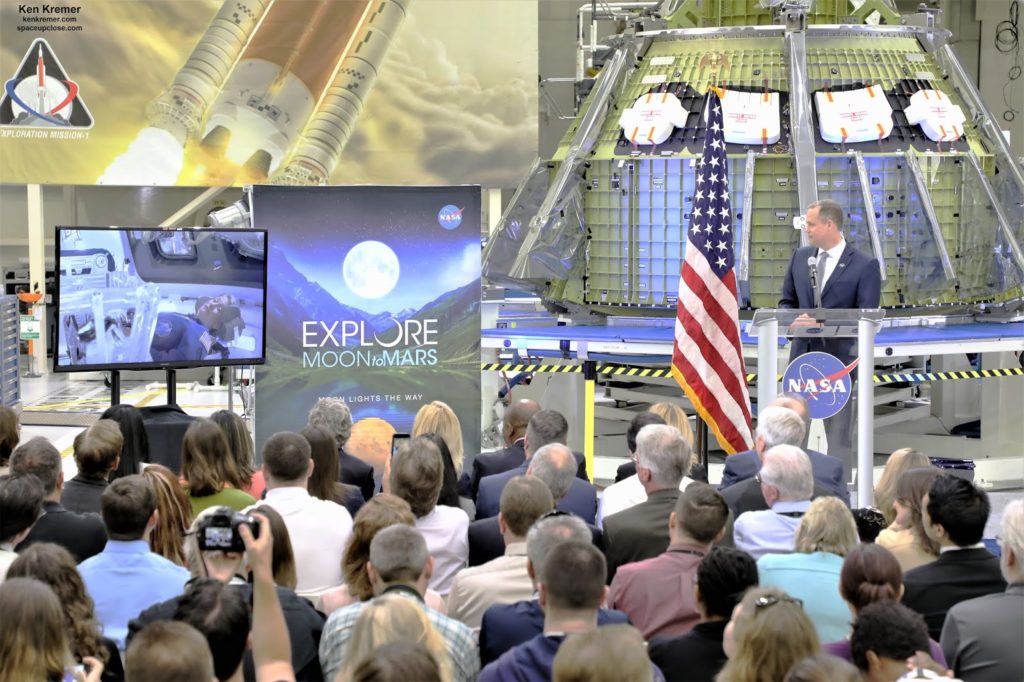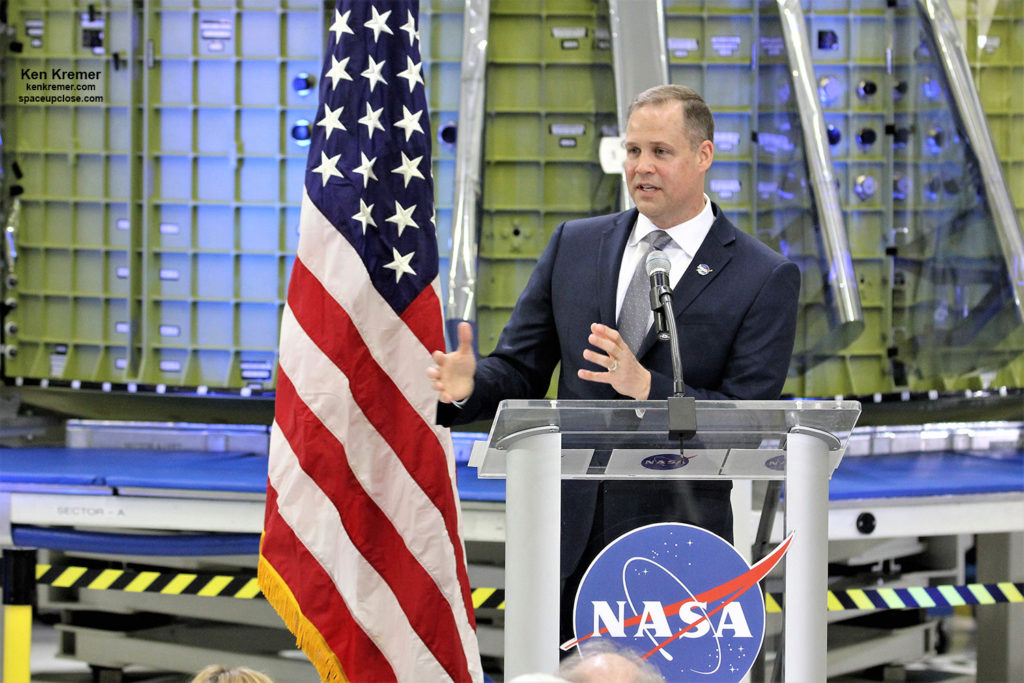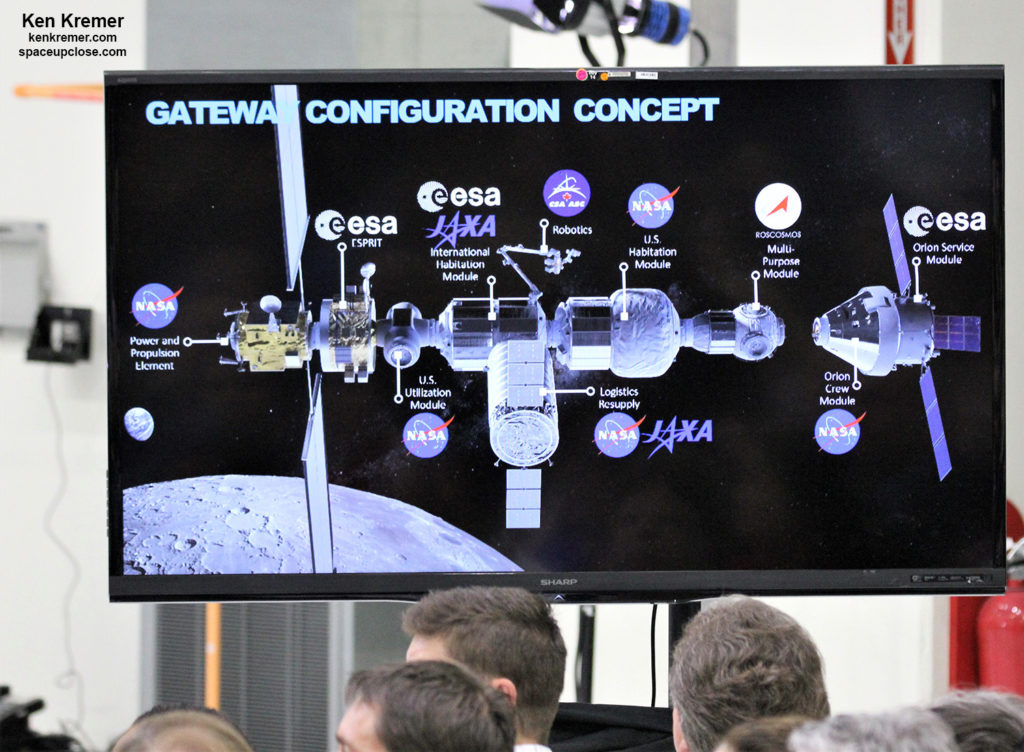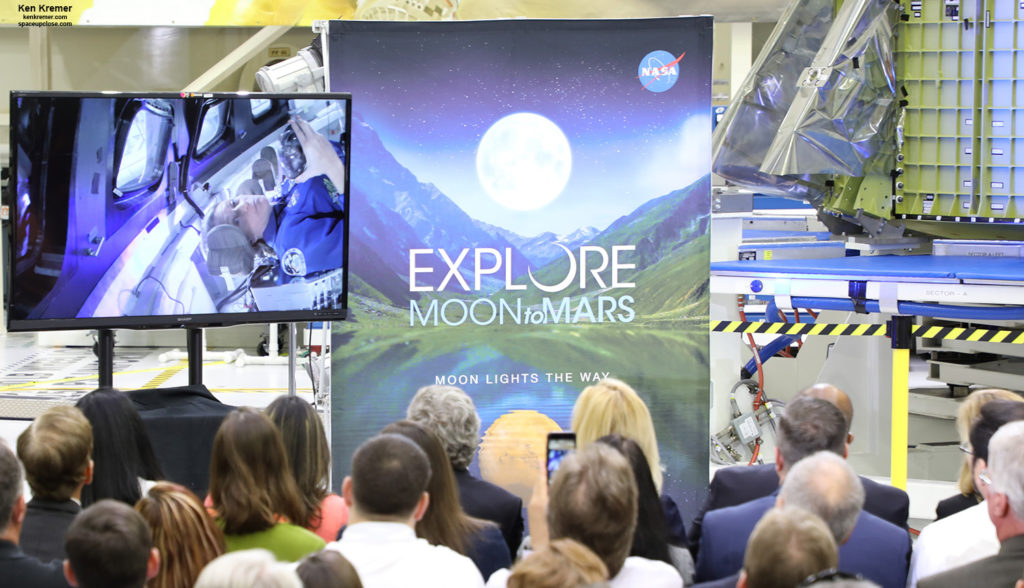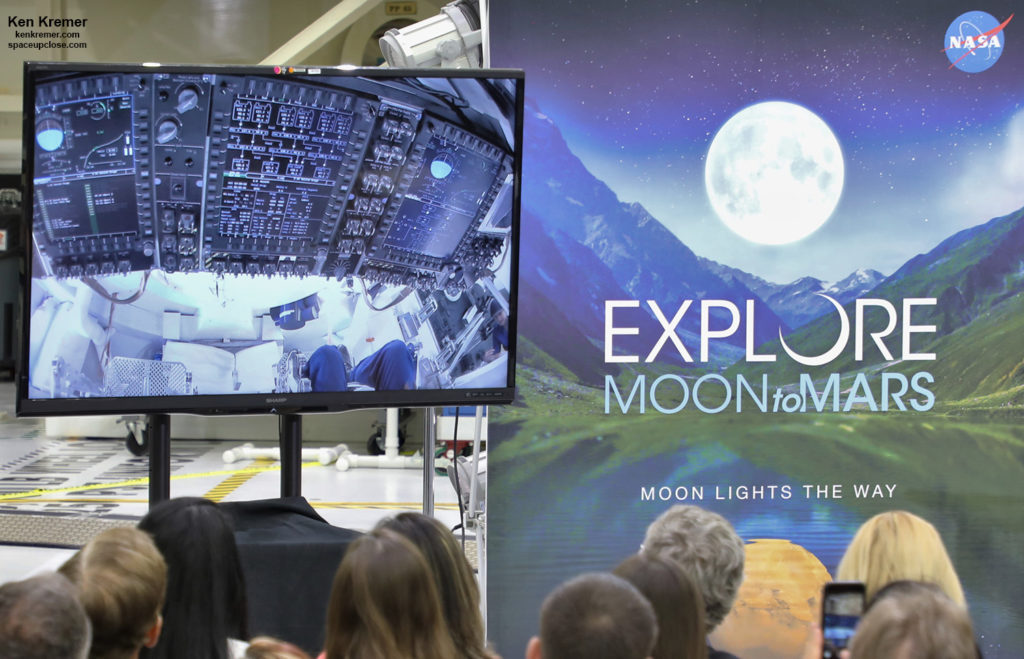2019
KENNEDY SPACE CENTER, FL – The Trump Administration proposed a top line NASA
budget of $21.02 Billion for Fiscal Year 2020, NASA Administrator Jim Bridenstine
announced during a budget rollout speech to employees and the media at the Kennedy
Space Center in Florida, Monday, March 11 – which actually amounts to a significant
2.2% cut that forces a slowdown in development of the agency’s SLS Moon to Mars
megarocket and eliminates several science missions like the WFIRST flagship
astrophysics space observatory.
Once again NASA is being asked to do more
with less – as the Trump Administration shifts NASA’s immediate focus and
funding to a human return to the Moon.
Trumps FY 2020 budget request fortifies lunar
exploration by fully funding NASA’s ‘Gateway’
lunar orbiting outpost as well as providing funds for a human lunar lander for
the first time in 10 years.
Overall President Trump has slashed NASA’s 2020
budget by $480 million compared to the actual Fiscal Year 2019 budget appropriated
and enacted by Congress in February 2019 – which amounted to $21.5 Billion.
Thus it will be up to the US Congress to act
in a bipartisan manner to save NASA science – that is if they choose to do so.
The NASA 2020 budget proposal from the Office
of Management and Budget (OMB) calls for $820 million for building the ‘Gateway’
mini lunar outpost and $363
million for accomplishing a human lunar landing with a commercial lander
by 2028 and was highlighted in NASA Administrator Jim Bridenstine’s speech at
the Kennedy Space Center (KSC). But he made no mention of slowing SLS
development.
“I want everybody to
know that NASA’s budget request is very good,” Bridenstine said at KSC. “We’re
going to be able to accomplish more than we’ve ever been able to accomplish
before because of the administration’s support.”
“For the first time in over 10 years, we
have money in this budget for a return to the moon with humans. I’m talking human-rated landers, compatible
with Gateway, that can go back and forth to the surface of the moon.”
Enjoy
our Space UpClose eyewitness photos attending the event as media.
But for all the talk by President Trump of
supporting NASA and signing ‘Space Policy Directive One’ in December 2017 which
states – “the United States will lead the return of humans to the Moon for long-term
exploration and utilization, followed by human missions to Mars and other
destinations” – the budget reality is disappointingly far different.
NASA is developing the Space Launch System
(SLS) heavy lift booster and Orion crew capsule to send astronauts back to the
Moon.
However funding for SLS has been cut by $375
million or 17% and development of the new improved performance Block 1B version
is deferred as development of the more powerful Exploration Upper Stage (EUS)
is deferred. Orion will be cut by about $84
million.
Thus SLS will be insufficiently powered in
its initial Block 1 version and NASA will not be able to ‘co-manifest’ heavier payloads such as elements of Gateway together
with the Orion crew capsule.
“The Budget defers upgrades to the SLS known
as “Block 1B”, which are not needed for missions planned during the first half
of the 2020s. Funding is instead focused on completion of the initial version
of the SLS and supporting a reliable SLS and Orion annual flight cadence,” the
budget document states.
NASA is currently building the Orion Exploration
Mission-1 (EM-1) and EM-2 capsules at KSC for the first two uncrewed and crewed
test flights in the early 2020s – but launch dates are TBD.
“Due to ongoing challenges, these dates are
under review pending completion of independent assessment of core stage
production and the integrated mission schedule,” the budget document states.
Bridenstine unveiled an aspirational concept
for Gateway that would launch its first US element in 2022- the power and
propulsion module. It will be maneuverable to other orbits around the moon to
enable exploration of vast areas with both robots and humans.
NASA hopes to launch the first commercial lunar
lander with NASA payloads by late 2019 or early 2020.
The Gateway mini station would hopefully include
elements from international partners.
Canada has already signed up as the first
partner and will build the Canadarm3 robotic arm.
Additional elements from NASA and partners such as the Habitation module and ESPRIT element contributions – yet to
be agreed to – would enable the first human
Orion crew to board Gateway in 2024 on EM-3.
“Beginning with a series of small
commercial delivery missions to the Moon as early as this year, we will use new
landers, robots and eventually humans by 2028 to conduct science across the
entire lunar surface,” Bridenstine
elaborated.
“The president has given us Space Policy
Directive 1, which says to go back to the moon, and we’re going to do that in
short order. Maybe even in 2019, but at least by 2020 — with commercial lunar
payload services that are going to be funded through the Science Mission
Directorate, and all of this is going to be possible because we’re looking at
going fast.”
Thus while the FY 2020 NASA budget does have
some very good news by increasing funds for human and robotic lunar missions, this
request is a severe setback for most other areas of science including planetary
science and astrophysics.
Overall the NASA science budget is cut by $602
million or nearly 10% from $6.9 Billion to $6.3 Billion.
Planetary Science is cut by $136 million, Earth
Science by $136 million and Astrophysics by $299 million.
The Europa Clipper mission is funded with almost
$600 million but would launch on a commercial rocket in 2023 rather than SLS.
The Mars 2020 robotic rover mission is fully
funded and will include the first ever ‘Mars Helicopter’ said Bridenstine. A Mars
Sample Return mission also receives startup funding of $109 million.
“The Budget also provides funding for a Mars
Sample Return mission launching as early as 2026 that will bring samples
collected by Mars 2020 back to Earth,” reads the budget document.
Furthermore President Trump once again stipulates
total mission termination for the flagship Wide-Field
Infrared Survey Telescope (WFIRST) space telescope – the highest
priority in astrophysics as outlined in NASA’s decadal survey. This would save $383
million.
On top of that NASA STEM science education is
again zeroed out from $110 million to NOTHING.
“Consistent with prior budgets, provides no
funding for PACE, CLARREO-Pathfinder, and the Office of Science, Technology,
Engineering, and Mathematics (STEM) Engagement,” reads the NASA budget document.
The oft delayed James Webb Space Telescope
(JWST) is fully funded at $352 million with launch delayed from 2018 to 2021.
“It has been a challenge for me, as your NASA
administrator, to go up to the hill and talk about the James Webb Space
Telescope,” Bridenstine said. “Some of you might have seen those hearings, and
they’re not fun. But I will also tell you this: this administration is
committed to the James Webb Space Telescope, and we have bipartisan support.”
crew vehicles SpaceX Crew Dragon and Boeing Starliner continue at $1.828 billion and the International Space
Station at $1.458 billion.
uncrewed Demo-1 test flight of Crew Dragon. Boeing Starliner could lift off as
soon as next month.
“We just saw a SpaceX Crew Dragon dock with the
International Space Station, deliver some cargo, ultimately do a lot of tests,
undock, fly home and land safely,” Bridenstine said at KSC.
“That is a first step in a much longer mission
for NASA to become one customer of many customers in low-Earth orbit in a
robust commercial marketplace.”
NASA hopes that crewed flights can begin
later this year- restoring America’s ability to launch astronauts from American
soil and end our sole reliance on Russia since the forced shutdown of the Space
Shuttle in 2011.
to end all ISS funding in 2025 – as it did last year to massive opposition in
Congress.
Station which will be used to facilitate a transition to a more robust and
cost-effective commercial approach to human space activities near the Earth,” the budget document states.
The good news – if you can call it that
– is NASA’s budget was cut less than those of other essential US science agency’s.
For example; the National Science Foundation
(NSF) budget was cut 12%, the National Institute of Health (NIH) cut 13%, and
EPA cut 31%.
Clearly investments in science, medical research
and environmental protection are not priorities of the Trump Administration.
Congress if you’re listening, please save
NASA and the other US Science Agency’s which are essential drivers to US science,
research and development upon which our economic growth, innovation and job
growth depend.
Watch for Ken’s continuing
onsite coverage of NASA, SpaceX, ULA, Boeing, Lockheed Martin, Northrop Grumman
and more space and mission reports direct from the Kennedy Space Center, Cape
Canaveral Air Force Station, Florida and Wallops Flight Facility, Virginia.
Stay tuned here for Ken’s continuing Earth and
Planetary science and human spaceflight news: www.kenkremer.com –www.spaceupclose.com – twitter @ken_kremer
– email: ken at kenkremer.com
Dr. Kremer is a research scientist and journalist based in the KSC
area, active in outreach and interviewed regularly on TV and radio about space
topics.
Ken’s photos are for sale and he is available for lectures and outreach events
Learn more about the upcoming/recent ULA Delta 4 WGS-10, SpaceX Demo-1, Falcon 9 Nusantara Satu launch, USAF GPS 3-01, SpaceX Falcon 9/CRS-16 launch
to ISS, NASA missions, ULA Atlas &
Delta launches, SpySats and more at Ken’s upcoming outreach events at Quality Inn Kennedy Space Center, Titusville,
FL, evenings:
Mar
14/16: “ULA Delta 4 WGS-10
launch, SpaceX Falcon 9 Demo-1 and Nusantara Satu launch, Dragon CRS-16 resupply launch to ISS, SpaceX
Falcon GPS 3-01, SpaceX Falcon Heavy & Falcon 9 launches, upcoming SpaceX
Falcon 9 USAF GP3 3-01, NRO & USAF Spysats, SLS, Orion, Boeing and SpaceX
Commercial crew capsules, OSIRIS-Rex, Juno at Jupiter, InSight Mars lander, Curiosity
and Opportunity explore Mars, NH at Pluto, Kuiper Belt and more,” Kennedy Space
Center Quality Inn, Titusville, FL, evenings.
Photos for sale
upcoming talks:
Mars; The Search for Life & A Journey in 3-D.” 7 PM, Lawton C
Johnson Middle School, Summit, NJ


